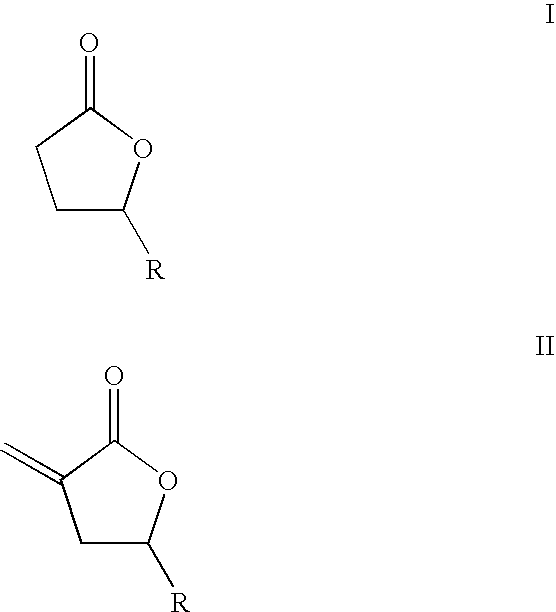Supercritical fluid phase synthesis of methylene lactones using novel catalyst field of invention
a technology of methylene lactone and supercritical fluid, which is applied in the direction of physical/chemical process catalysts, metal/metal-oxide/metal-hydroxide catalysts, bulk chemical production, etc., can solve the problems of unfavorable decrease in activity with time on stream, and achieve high initial activity, high reactor productivity, and high activity and productivity with time on stream
- Summary
- Abstract
- Description
- Claims
- Application Information
AI Technical Summary
Benefits of technology
Problems solved by technology
Method used
Image
Examples
example 1
[0086] The reactor was charged with 0.48 g of 20% Rb / Davicat® Si 1700 catalyst (Catalyst 1). The reactant feed solution consisted of 52.3 mol % GVL, with the balance made up with the ethanol hemiacetal solution. This solution resulted in a 1.2:1 ratio of formaldehyde to GVL in the reactor feed, which was metered at a rate resulting in a weight hour space velocity (WHSV) in the reactor of 1.17 g GVL / (g catalyst-h). CO2 was used as the SCF solvent phase, and the flow rate was metered independently to give a final total organic concentration of 3.0 mol % in the reactor feed. The reactor was operated at a temperature of 245° C. and a pressure of about 23.5 MPa. The cumulative turnover number for the reaction was 23.0 mol GVL converted / mol of catalyst, the overall reactor productivity was 1.17 g MeMBL / g catalyst-h, and the corresponding reaction profile showing conversion of GVL to MeMBL is summarized below:
Time onGVLMeMBLReactorStreamConversionSelectivityProductivity(h)(%)(%)(g MeMBL / ...
example 2
[0087] The reactor was charged with 0.57 g of 20% Rb / Davicat® Si 1405 catalyst (Catalyst 2). The reactant feed solution consisted of 52.3 wt % GVL, with the balance made up with the ethanol hemiacetal solution. This solution resulted in a 1.2:1 ratio of formaldehyde to GVL in the reactor feed, which was metered at a rate resulting in a weight hour space velocity (WHSV) in the reactor of 1.17 g GVL / (g catalyst-h). CO2 was used as the SCF solvent phase, and the flow rate was metered independently to give a final total organic concentration of 3.6 mol % in the reactor feed. The reactor was operated at a temperature of 245° C. and a pressure of about 23.5 MPa. The cumulative turnover number for the reaction was 23.2 mol GVL converted / mol of catalyst, the overall reactor productivity was 1.16 g MeMBL / g catalyst-h, and the corresponding reaction profile showing conversion of GVL to MeMBL is summarized below:
Time onGVLMeMBLReactorStreamConversionSelectivityProductivity(h)(%)(%)(g MeMBL / g...
example 3
[0088] The reactor was charged with 0.61 g of 20% Rb / Davicat® Si 1415 catalyst (Catalyst 3). The reactant feed solution consisted of 48.3 wt % GVL, 7.7 wt % p-xylene as an internal standard, and the balance was made up with the ethanol hemiacetal solution. This solution resulted in a 1.2:1 ratio of formaldehyde to GVL in the reactor feed, which was metered at a rate resulting in a weight hour space velocity (WHSV) in the reactor of 1.26 g GVL / (g catalyst-h). CO2 was used as the SCF solvent phase, and the flow rate was metered independently to give a final total organic concentration of 3.9 mol % in the reactor feed. The reactor was operated at a temperature of 250° C. and a pressure of about 20.1 MPa. The cumulative turnover number for the reaction was 10.2 mol GVL converted / mol of catalyst, the overall reactor productivity was 1.28 g MeMBL / g catalyst-h, and the corresponding reaction profile showing conversion of GVL to MeMBL is summarized below:
Time onGVLMeMBLReactorStreamConver...
PUM
| Property | Measurement | Unit |
|---|---|---|
| diameter | aaaaa | aaaaa |
| diameter | aaaaa | aaaaa |
| temperature | aaaaa | aaaaa |
Abstract
Description
Claims
Application Information
 Login to View More
Login to View More - R&D
- Intellectual Property
- Life Sciences
- Materials
- Tech Scout
- Unparalleled Data Quality
- Higher Quality Content
- 60% Fewer Hallucinations
Browse by: Latest US Patents, China's latest patents, Technical Efficacy Thesaurus, Application Domain, Technology Topic, Popular Technical Reports.
© 2025 PatSnap. All rights reserved.Legal|Privacy policy|Modern Slavery Act Transparency Statement|Sitemap|About US| Contact US: help@patsnap.com



